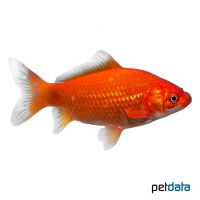Goldfish (Carassius auratus)
| Goldfish Carassius auratus | |
|---|---|
| Name | Goldfish |
| Name Lat. | Carassius auratus |
| Family | Carps |
| Family lat. | Cyprinidae |
| Order | Carps |
| Order lat. | Cypriniformes |
| Origin | Asia (breeding variety) |
| Habitat | Ponds |
| Diet | Omnivore |
| pH | 6.0-9.0 |
| Behavior | Peaceful |
| Keeping | Group |
| Care Level | Easy |
| Reproduction | Egg scatterer |
| Breeding | Moderately difficult |
| Life Span | 10-20 years |
| Protection | No |
| Metric Units | |
| Size | 20-30 cm |
| Temperature | 4-30 °C |
| Hardness | 10-30 °dH |
| Aquarium | Pond |
| US Units | |
| Size | 8"-12" |
| Temperature | 39-86 °F |
| Hardness | 178-534 ppm |
| Aquarium | Pond |
Distribution and habitat
Already in the 11th century in China from red-gold color morphs of the silver crucian carp, according to other sources from the gable, the goldfish was bred out. Via Japan, the goldfish, bred in many different varieties, spread worldwide and can today be described as domesticated
Maintenance
The pond should be furnished with pond, floating and oxygenating underwater plants (milfoil, waterweed, hornwort, etc.), large river pebbles, and a substrate of sand and round-grained gravel and provide free swimming space
When maintaining in a cold water aquarium, care should be taken to provide adequate swimming space in addition to robust perimeter planting and numerous hiding places (roots, rocks). A substrate of fine, round-grained gravel or aquarium sand and slightly shaded light (floating plants) is ideal.
No ammonia, ammonium and nitrite should be detectable in the water, and the nitrate value should not exceed 50 mg/l. To ensure the water quality and oxygen content should not be missing a filter adapted to the water volume.
Diet
They are easy to feed. For a balanced diet, feed once a day with a high-quality dry food for goldfish (flakes, sticks, granules, pellets) with low protein content (below 30%). In addition, they need vegetable food, such as aquatic plants (Egeria densa, Cabomba caroliniana, Rizzia flutians, etc.) or scalded leaves (spinach, dandelion) or dry food with high vegetable content (spirulina). Occasionally, daphnia, tubifex or mosquito larvae (live or frozen) should also be offered.
It is recommended to feed small portions several times a day, which are eaten within a few minutes. A regular and varied diet promotes health and prevents deficiency symptoms.
Behaviour and compatibility
They are calm, peaceful and sociable fish that do not exhibit any aggressive or incompatible behaviors. At least 5 goldfish should be kept together.
In principle, only mutually compatible fish species with similar requirements for water quality and water temperature may be socialized.
Reproduction and breeding
The sexes are difficult to distinguish, males are slightly more slender and have a concave (indented) anal opening.
After a pronounced courtship behavior, up to 1,000 and often more eggs are laid. The larvae hatch after five days.
Important
If goldfish are overwintered in the pond, ensure sufficient depth and oxygen supply (filter, oxygen dispenser, ice free holder).
At temperatures below 10 °C, the metabolism of the goldfish slows down and no more food is accepted; feeding must be stopped accordingly. If the temperature drops further, they burrow into the mud and go into hibernation. In spring, with rising temperatures, feeding can slowly be resumed. Feeding may also be necessary during prolonged warm periods in winter.
The well-being of the fish should be monitored regularly. A regular partial water change, according to the pond size is recommended, even if the pollutant load has not yet reached the upper limit. Sudden changes in water quality should be avoided. Newly introduced fish must be accustomed slowly to the water in the pond or aquarium
Further literature can be found in your pet store.
References
Text: petdata; Image: petdata
Source: BMELV (1998): Tierschutzgutachten - Haltung von Zierfischen (Süßwasser); RIEHL & BAENSCH (2006): Aquarien Atlas Bd. 1, Mergus Verlag; ENGELMANN (2005): Zootierhaltung - Tiere in menschlicher Obhut: Fische; Harri Deutsch Verlag
- Gemäß § 21 Abs. 5 Tierschutzgesetz idgF
